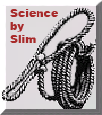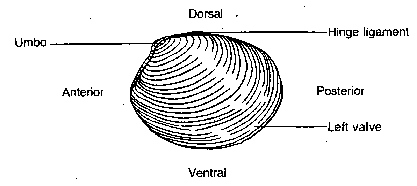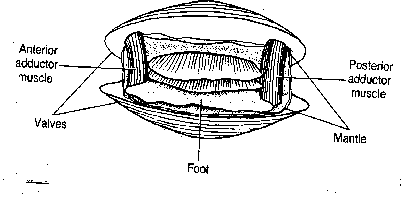 |
Clam Dissection |
 |
Printable version: Clam Dissection
Introduction
The
phylum Mollusca includes snails, clams, chitons, slugs, limpets, octopi,
and squid. As mollusks develop from a fertilized egg to an adult, most pass
through a larval stage called the trocophore. The trocophore is a
ciliated, free-swimming stage. Mollusks also have a radula or file-like
organ for feeding, a mantle that may secrete a shell, and a muscular foot
for locomotion. Clams are marine mollusks with two valves or shells. Like
all mollusks, a clam has a mantle which surrounds its soft body. It also has a
muscular foot which enables the clam to burrow itself in mud or sand. The soft
tissue above the foot is called the visceral mass and contains the clam's
body organs.
Phylum - Mollusca
Class - Bivalvia or Pelecypoda
Objective
To study the internal and
external anatomy of a bivalve mollusk.
Materials
Dissecting pan, dissecting
kit, screwdriver, lab apron, safety glasses, preserved clam
|
|
Clam Dissection Questions |
Pre-lab:
1. Give the kingdom, phylum, and class for the clam.
2. Give several examples
3. What is the mantle and give its function?
4. What controls the opening and closing of the clam's shell?
5. How do clams move?
6. How do clams feed?
7. Why are clams called bivalves?
Procedure
1. Put on your lab apron & safety glasses.
2. Place a clam in a dissecting tray and identify the
anterior and posterior ends of the clam as well as the dorsal, ventral, &
lateral surfaces. Figure 1
Figure 1

The left valve is on top if your clam is correctly positioned.
The siphons are at the posterior end. If the siphons
are not visible, determine which is the ventral side by using the umbo. The umbo
is the bump on the top of the shell. It leans toward the anterior end. Notice
that the siphon is actually made of two siphons. If you cannot see the siphon
now, remember to look closely at it after you open the shell. The ventral siphon
carries water into the shell and the dorsal siphon removes the water.
3.
Locate the umbo, the bump at the anterior end of the valve. This is the
oldest part of the clam shell. Find the hinge ligament which hinges the
valves together and observe the growth rings.
4.
Turn the clam with its dorsal side down and insert a screwdriver between the
ventral edges of the valves. Carefully work the tip of the screwdriver
between the valves (opposite the umbo) so you do not jab your hand.
5.
Turn the screwdriver so that the valves are about a centimeter apart. Leave the
tip of the screwdriver between the valves and place the clam in the pan with the
left valve up.
6.
Locate the adductor muscles. With your blade pointing toward the dorsal
edge, slide your scalpel between the upper valve & the top tissue layer. Cut
down through the anterior adductor muscle, cutting as close to the shell
as possible.
The shells are held together by two muscles called the anterior
and posterior adductor muscles. Remove the left shell by inserting the scalpel
blade between the shell and the mantle and cutting the adductor muscles away
from the left shell. It is important to keep the blade against the shell so that
you are scraping the adductor muscle off the shell more than cutting it. If the
shells are still tightly shut, you will have to work the scalpel blade in
between the shells carefully. Get help from your instructor if you are having
difficulty.
7. Repeat step 6 in cutting the posterior adductor muscle. Figure 2
Figure 2

8. Bend the left valve back so it lies flat in the
tray.
Once both adductor muscles have been cut away from the left
shell, the shell can be opened easily. As the shell is opened, the mantle
should be pushed away from the shell so that it is not torn. You can remove the left shell to get it out of the way
if you want.
9. Run your fingers along the outside and the inside
of the left valve and compare the texture of the two surfaces.
10. Examine the inner dorsal edges of both valves near
the umbo and locate the toothlike projections. Close the valves & notice how
the toothlike projections interlock.
11. Locate the muscle "scars" on the inner
surface of the left valve. The adductor muscles were attached here to hold the
clam closed.
12. Identify the mantle, the tissue that lines
both valves & covers the soft body of the clam. Find the mantle cavity,
the space inside the mantle.

13.
Locate two openings on the posterior end of the clam. The more ventral opening
is the incurrent siphon that carries water into the clam and the more
dorsal opening is the excurrent siphon where wastes & water leave.
The large muscle attached to the siphons is called the siphon
retractor muscle. There would be another one on the right side. These muscles
pull the siphon in. Most clams can retract the siphons completely into the
shell. Some large clams like the Geoduck have such a large siphon that it
doesn't fit into the shell. The siphon brings water into the clam so the siphons
have to reach from the clam's body to the water. If the clam is buried 15 cm
below the surface, the siphons would have to be able to stretch that far.
14.
With scissors, carefully cut away the half of the mantle that lined the left
valve. After removing this part of the mantle, you can see the gills,
respiratory structures.
The next step is to remove the left mantle along with the siphon
retractor muscle. Cut the mantle away with a scalpel. Be careful not to cut the
gills. Lift the mantle up as you cut and notice how thin it is. Removing the
mantle exposes the gills and the foot. You can see the visceral mass better now
as well. In clams like the one pictured, the labial palps are close to the
anterior adductors muscle. The labial palps are two flap-like structures that
are close to the mouth. Notice the structure of the gills. Bivalves are filter
feeders. The gills are used to strain plankton out of the water, as well as to
remove oxygen from the water. There are another pair of gills on the right side
of the clam. The accompanying diagram shows these parts. You can see the edge of
the right mantle below the foot and visceral mass.
15.
Observe the muscular foot of the clam, which is ventral to the gills.
Note the hatchet shape of the foot used to burrow into mud or sand.
16. Locate the palps, flaplike structures that surround & guide food into the clam's mouth. The palps are anterior to the gills & ventral to the anterior adductor muscle. Beneath the palps, find the mouth.

17. With scissors, cut
off the ventral portion of the foot. Use the scalpel to carefully cut the muscle
at the top of the foot into right and left halves.
18.
Carefully peel away the muscle layer to view the internal organs.
19.
Locate the spongy, yellowish reproductive organs.
20. Ventral
to the umbo, find the digestive gland, a greenish structure that
surrounds the stomach.
21.
Locate the long, coiled intestine extending from the stomach.
22.
Follow the intestine through the clam. Find the area near the dorsal surface
that the intestine passes through called the pericardial area. Find the
clam's heart in this area.
23.
Continue following the intestine toward the posterior end of the clam. Find the anus
just behind the posterior adductor muscle.
24.
Use your probe to trace the path of food & wastes from the incurrent siphon
through the clam to the excurrent siphon.
To see where the heart is located look above the visceral mass above the gills. There is a clear looking region near the top of the clam. The heart is contained in a thin-walled sac called the pericardium. To get a better view of this region, take the clam out of the shell so you can look at the dorsal side. The clam should come out of its shell fairly easily if you cut the adductor muscles away from the right shell. Looking down on the dorsal side will enable you to see the pericardium. The tube-like structure that runs through the pericardium is the intestine.
25. Answer the questions on your lab report &
label the diagrams of the internal structures of the clam. Also, use arrows on
the clam diagram to trace the pathway of food as it travels to the clam's
stomach. Continue the arrows showing wastes leaving through the anus.
|
|
Clam Dissection Questions |
Lab Questions:
What is the oldest part of a clam's shell called and how can it be located?
What do the rings on the clam's shell indicate?
What is the function of the toothlike projections at the dorsal edge of the clam's valves?
Where is the mantle located in the clam?
What is the mantle cavity?
Where are the incurrent & excurrent siphons located and what is their function?
How do clams breathe?
Describe the shape of the clam's foot?
Where are the palps found and what is their function?
Describe the movement of food from the current siphon through the digestive system of the clam.
Where is the clam's heart located?
Why are clam's referred to as "filter feeders"?
Label the internal structures of the clam and draw arrows showing the pathway of food as it travels to the clam's stomach:
List found @ http://serc.carleton.edu/microbelife/topics/marinesymbiosis/qpx_dissection.html
Alternatives to Dissections can be found here
Dissections Online @ University at Buffalo
Clam Dissection Pics http://iweb.tntech.edu/mcaprio/clam.htm
from Tennessee
Technological University,
in Cookeville, Tennessee
![]() Clam Dissection Pics from Cornell University
Clam Dissection Pics from Cornell University
|
Report Bad Hyper
Links Here
|